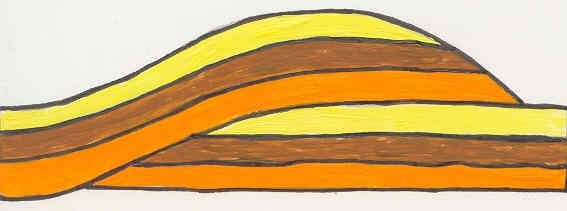What are Thrust Faults?
Thrust fault and reverse faults
Compressed land creates thrust faults
Thrust faults occur when one section of land slips over another at a low angle when the land is compressed. Thrust faults do not usually show on the surface of the Earth.
Angle is steeper in a reverse fault
A reverse fault forms when two landmasses are being compressed together like a thrust fault. The difference between the two faults is the angle of the fault. The angle of the fault plane in a reverse fault is greater than 45 degrees The hanging wall on one side of the fault moves upward and is usually visible on the surface of the Earth.

Diagram showing how one section of land slips over another in a thrust fault. M. Martin
Where faults form
Coast ranges in subduction zones
Subduction zones often have multiple faults where land on the ocean floor is scraped off the oceanic plate.The faults pile up on the continent. The coast range Oregon, Washington and parts of California formed in this manner.
Formation thrust fault
Thrust faults form when the angle is less than 45 degrees. The angle allows one section of the land to go over the top of the other block of land.
Crust thickens
This type of fault movement thickens and shortens the crust. A normal fault develops where land is pulling apart and one block of land drops down. Blocks of land that move up or down in normal and reverse faults have steeply inclined planes.


Click for More Information and to Order
Blind thrust fault
Type of reverse fault
A blind fault occurs in areas a shallow-dipping reverse fault terminates before it reaches the Earth's surface. Tension in the crust will cause the rocks to fracture but the fractures does not have any surface features. Many unknown thrust faults are suspected in California. Some faults are not discovered until a major earthquake occurs.
Northridge earthquake
1994 Northridge earthquake
The 1994 Northridge earthquake was caused by a blind fault that scientists did not know about until it occurred. The earthquake killed 61 people and approximately $40 billion in damage. The fault line is between 12 miles at its southern edge and 3 miles below the Earth's surface at its northern edge. About 10 to 12 miles of land broke along the fault plane during the earthquake.
Break along fault line
The actual break only took about 8 seconds but the shaking in the area due to sediments lasted between 20 and 30 seconds. The movement along the fault was approximately 13 feet.
No foreshocks
Everyone in the region included seismologists were taken by surprise. There were no foreshocks and no strain was seen in the rocks at any time before the earthquake occurred.
KIDS FUN Science Bookstore
Check out Myrna Martin's award winning textbooks, e-books, videos and rock sets. The Kids Fun Science Bookstore covers a wide range of earth science topics. Click here to browse.










